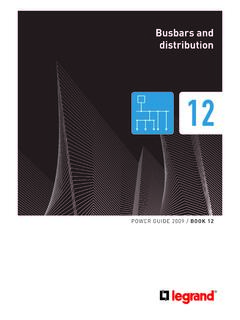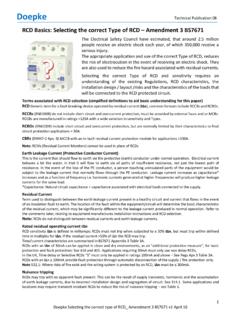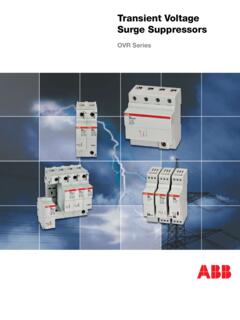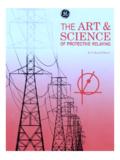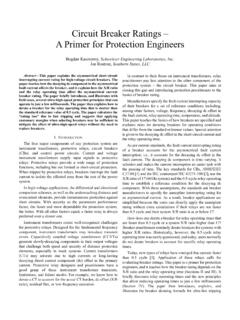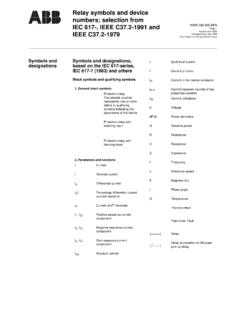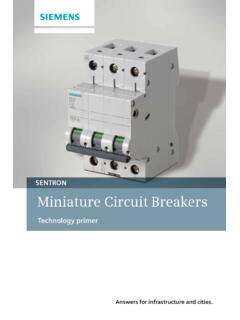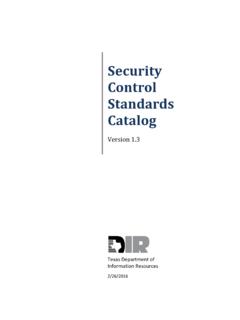Transcription of protection devices - Legrand
1 Sizing conductors and selecting protection devicesPowEr guidE 2009 / BOOk 0404 Careful selection of the sizes of the conductors in wiring systems and the characteristics of protection devices will ensure basic protection of the installation:- protection against overloads- Limitation of voltage drops- protection against short-circuits- Checking of the thermal stresses- protection against indirect contactCareful selection of the sizes of the conductors in wiring systems and the characteristics of protection devices will ensure basic protection of the installation:- protection against overloads- Limitation of voltage drops- protection against short-circuits- Checking of the thermal stresses- protection against indirect contactINTrOThe complete calculation of installations has been found to be so long, complex, and even daunting as to justify the ongoing development of practical aids: calculation charts, note-boards, etc.
2 And now software, such as XL Pro2 Calculation. we must not however let the absolute accuracy, reliability and ease of use of these tools make us lose sight of the calculation principles on which they are based. The purpose of this book is to cover the main rules that are used for sizing conductors, wiring systems and their electrical protection (against overloads, voltage drops, short-circuits and indirect contact) according to the parameters of the installation: physical (type of conductor, installation conditions, temperature, length of lines, etc.) and electrical (power, prospective short-circuit, operating currents, etc.). Examples of how they are determined are given for each parameter. The complete process for estimating the short-circuit currents at all levels in the installation is illustrated on page rules for selecting and mounting wiring systems are specified in standard IEC 60364-5-52.
3 CENELEC guide r064-003 gives a rigorous calculation method suitable for calculation software. In practice two approximate methods are used. These are called the conventional method and the composition 02 Short-circuits 03 Calculation principle for installations 04 protection against overloadsDetermination of the actual operating current IB 06 Cross-section of conductors 071 Characteristics of the conductors 082 Wiring systems: installation methods 083 Group of circuits 124 Ambient temperature 175 Risks of explosion 196 Parallel conductors 197 Global correction factor 198 Cross-section of the neutral conductor 22 devices for protection against overloads 231 Location and choice of protection devices 232 Exemption from protection against overloads 233 Recommendation for no protection against overloads 23
4 Checking voltage dropsChecking voltage drops 24 protection against short-circuitsBreaking capacity 28 Checking the thermal stresses permitted by conductors 291 Live conductors 302 Protective conductors 31 Checking the maximum protected lengths 32 protection against indirect contactTT system 36TN system 371 Breaking time 372 Fault current 373 Maximum protected lengths 38IT system 391 On the first fault 392 On the second fault 39 Checking the maximum protected lengths 40 Solutions when the tripping conditions are not met 451 Use of residual current devices 452 Use of low magnetic circuit breakers or curve B circuit breakers 453 Increasing the cross-section 454 Creating additional equipotential links 45
5 Estimation of short-circuits and calculation exampleShort-circuit value at the origin of the installation 461 Supply via HVA/LV transformer 462 Supply via the mains 483 Supply via an alternator 48 Short-circuit value at any point 501 Impedance method 502 Composition method 52 Calculation example 54 ConductorsSelection and use of cables and conductors 58 Cable cores identification 65 Wiring in assemblies 661 Cross-sections of conductors 662 Selecting flexible bars 68 Dimensioning conDuctors anD Determining protection Devices02 OVERLOADSO vercurrentsAll live conductors in the installation (phase and neutral)
6 Must in principle be protected against overloads and overload is an overcurrent circulating when there is no electrical fault in a circuit It is caused by under-sizing of the wiring system for the load being supplied, or by the load being too high for the wiring system protection devices must be provided to break any overload current before the overheating of the conductor damages its insulation, its connections and the surrounding equipment protection against overloads can be provided by fuses (type gG), circuit breakers with thermal or electronic release or contactors with measurement relays aM fuses do not provide protection against overloads The rules for determining overload protection are described on page 06 > infrared thermography can be used to detect overloads, as shown here in a transformer windingthe devices for protecting the circuits in the installation are not designed to protect internal circuits in devices or flexible conductors (power supply cables of mobile devices ) connected to the power sockets.
7 It may be necessary to design appropriate separate protection devices if this is called for by the risk of overcurrents (for example, overload on motors).> the concentration of the conductors requires compliance with strict installation rules and the application of correction factors to the current -carrying capacities of the cables03 SHORT-CIRCUITSShOrt-CirCuitSin principle, all the lines must be protected against can be combined in order to increase the breaking capacity (see the Breaking and protection devices book). Exemption from protection is also possible in certain cases. the protection of conductors in parallel for the same circuit must be subject to special wiring short-circuit is an overcurrent produced by a minor impedance fault between conductors with different potentials It is accidental and can be due to clumsiness (dropping a tool, cutting a cable) or an equipment defect protection devices must be provided to limit and break the short-circuit currents before their thermal (heating of the conductors, electric arcs) and mechanical (electrodynamic forces) effects become harmful and dangerous protection against short- circuits can be provided by fuses (type gG or aM), by circuit breakers with magnetic relays or by circuit breakers with electronic relays (overcurrent)
8 Their breaking capacities and circuit opening times must be suitable for the circuit being protected The rules for determining short-circuit protection are described on page 28 et seq in equipment or installations, fault currents between live parts and exposed conductive parts generally arise as a result of a fault or ageing of the insulation. the circulation of the current may, depending on the value it reaches, create sparks, or even set alight the surrounding equipment. the choice of the neutral earthing system determines the maximum value of the fault currents. if there is a risk of fire:- the tN-C system is not allowed, as the currents can reach several kA and may even circulate in the structures of the buildings- the tN-S system is inadvisable unless residual current devices with sensitivity iAn <300 mA are added - the tt system is possible (limitation by residual current device)- the it system is recommended in intrinsic safety systems as the 1st fault current can be limited to a very low value (a few mA), to avoid the risk of arcing.
9 Caution: the 2nd fault must be protected by a residual current device iAn < 300 mA. in hazardous situations it is strongly recommended that preventive maintenance is carried out based on monitoring the insulation value of the whole installation: values indicated by the permanent insulation monitor (it) or regular campaigns to measure the insulation presence of contaminants, humidity or the ageing of the insulation leads to weak points in the insulation. if the test voltage value is significantly increased, a considerable reduction in the resistance value will be observed. the application of increasing measurement voltages, for example: 500 V, 1000 V, 1500 V, 2500 V, 5000 V, will reveal any defects if the insulation value drops by more than 25% at each increasing voltage level. Caution: the test value must remain much lower than the dielectric strength of the installation (min.)
10 2 u + 1000).Fault currentsDimensioning conDuctors anD Determining protection Devices04 CALCULATION PRINCIPLE FOR INSTALLATIONSO vercurrents (continued)The conductors must be sized and the protection condi-tions determined for each circuit in the installation The procedure is identical for every circuit and involves a number of steps, which are described below Calculate the actual operating current (iB) of the wiring system This value is derived by estimation of the total load connected with the receivers on the circuit concerned (see p 06) Determine the cross-section of the conductors to be used according to this actual operating current The current -carrying capacity (IZ) of a wiring system is dependent on the temperature it can withstand and its dissipation conditions The characteristics of the wiring system (type of core, type of insulation, number of conductors) and its circulation conditions (installation method, ambient temperature, group of several circuits) are therefore determining factors (see p 07 to 22) Select the overload protection device with the required rating (In) and if necessary determine its setting (Ir) (see p 06) Calculate the voltage drop in the wiring system according to its length and the actual operating current If this value exceeds the specified value, the cross-section of the conductors must be increased (see p 24) Calculate the maximum short-circuit current (Ikmax, fault at the origin of the circuit)
